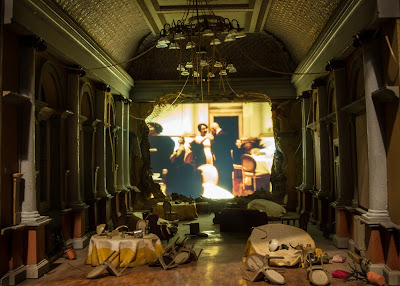Professor of Contemporary Art, Theory and Criticism at Middlesex, an art critic and historian with a specialism in feminist art criticism and theory about contemporary women artists.
An
introductory essay to Fran Cottell’s book, which collects together descriptions
of different interative installations in her home over a period of time.
Cooking Up the Self Bobby Baker and
Blondell Cummings “Do” the Kitchen by Lesley Ferris
Critical
writing with some historical background, analysing two different performance
artists; Bobby Baker stages her work in her own kitchen and Blondell Cummings performed
in kitchen ‘sets’.
Written by Lesley Ferris - Arts & Humanities Professor, Department of Theatre
at Ohio State University, a theatre director and scholar.
Blondell Cummings Chicken Soup –
video still 1989
https://danceinteractive.jacobspillow.org/blondell-cummings/chicken-soup/
 Bobby Baker Kitchen Show
Bobby Baker Kitchen Show Bobby Baker: Redeeming Features of Daily Life edited by Michèle Barrett and Bobby Baker (2007), Routledge.
Fran Cottell: “During the 1980s and 1990s I had started to think about the public/private relationships between and within the body (often represented by clothing) and or the spaces we occupy.”
Fran Cottell is the Fine Art Senior Lecturer at Camberwell.
“Since 2001, Cottell has used her own house as both subject and experimental site for her performative events, subtly altering this domestic environment through architectural interventions. (Camberwell website)
Back to Front installation 2011– photos by Terry Watts from Fran Cottrell’s website
The work made
interventions (eg viewing platforms, peepholes) over a period of time in her
own house in Greenwich and invited people in whilst going about her everyday
life with her family.
Platform for visitors to stand on
while family got on with daily life
Fran
Cottell’s interest has been in exploring the relationships between ‘inhabited
spaces’ – the body, the home, and the exterior world. (Introduction by Fran Cottell)
She found
that galleries were too public a space and wanted to explore ‘real experience’
– the interior space and the life that took place there.’
Collecting time – invited different
curators and critics to put their heads through a hole in her daughter’s
bedroom floor so that she could take a photo of them
In this
essay, Katy Deepwell writes about the work in the context of sculpture, and
cites Rosalind Krauss idea of the ‘expanded field’ –
“No longer an object to be looked at, the work
will literally put us in another place, create another kind of environment”.
Instead of
standing and looking at one fixed object in one space, the experience can be a
‘4D experience’, being immersed in an environment or installation, happening
over a period of time.
Some examples of other immersive installations for
comparison:
DreamThinkSpeaks’
Absent, Shoreditch Town Hall, 2015
photo Jim Stephenson
‘An intimate
promenade installation inspired by The Duchess of Argyll’s residence at a central
London hotel in the 1970’s’
14 Radnor Terrace
1974 – feminist art group SLAG – South London Art Group took over/squatted a
small terraced house as a large scale installation called ‘ A Woman’s Place’ - contemporary critique of family life.
In 2017 Raven
Row gallery reconstructed some of the work, the show was called 56 Artillery Lane in homage
Su Richardson
for Fenex 1977 (my photo) recreated in Raven Row in 2017
Conclusion:
Fran Cottell
explains in her introduction how a live ‘real’ experience is more vivid and
alive , something that it is not possible to deliver through a performance in a
gallery.
(I enjoyed
the Raven Row show very much but you can see how much more powerful it must
have been in the squatted house the artists had taken over in the 1970s.)
Also, by
inviting people into her home with her family, the work ‘invites viewers to
consider ‘where’ they are in the process of viewing the work: a viewer/a
resident, a participant/an observer, part of the life displayed/or on display” .
I felt that
Katy Deepwell and Lesley Ferris were both admirers of their respective artists’
work.The writing
was enthusiastic and keen to give the reader a personal impression of the
work, and to argue for its value.
Both pieces
admitted the work is not easy to convey in description. For this kind of live
work, to get the most out of it you really have to be there.
I also
thought that the pieces played down the humour of this work, as though if something is
funny, it can’t also be serious and meaningful.
I liked Fran
Cottell’s remark on her visitors.
“Most people reacted with humour… although
some… reported back afterwards, complaining that they had been unable to sleep,
after a visit, because they found it unsettling’.
Questions:
It is alive
and vivid , more so that a traditional gallery installation, but not repeatable,
recordable (or sellable?)
I wondered why
the book was only available as a download?








No comments:
Post a Comment